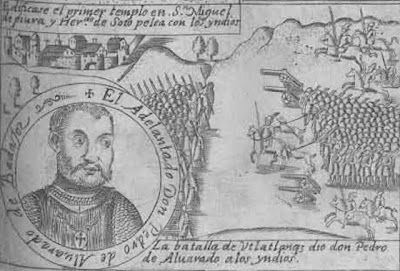 |
| The K'iche' (on the left) make a final hopeless stand against the invaders. |
This plate depicts the assault of Pedro de Alvarado against the Guatemalan city of Q'umarkaj, which ended in a decisive victory for the 450 Spanish and their Tlaxcalan allies. Alvarado, who had nearly ruined Cortes' expedition against the Aztecs a few years earlier with a preemptive massacre, was notoriously cruel and brutal. After the battle depicted here he burned the city and its inhabitants as an example to other opposition groups, resulting in a swift capitulation of the surrounding native states.
In the center of the formation are rows of formed infantry, supported on the flanks and front by loose cavalry. Note the use of war dogs in front of the line as special assault forces, ahead of the infantry. These dogs were given quilted armor and spiked collars as protection, and were trained to be vicious and bloodthirsty. The utility of dogs is a particular feature of this kind of asymmetric engagement; in a balanced European battle, dogs would be less effective against steel weapons and firearms.
Finally, the cannons on the wings of the front line are distributed symmetrically and mounted on wheeled gun carriages. These are probably falconets firing dispersive grapeshot munitions in order to cause wide area damage. The Spanish had an ample supply of sulfur and saltpeter from the active volcanoes of Central Mexico.
The combination of cannons, horses, and dogs points to the psychological component of warfare, a critical element in battles where the technologically advanced invaders were at a severe numerical disadvantage. These weapons were designed less to cause immediate death than to sow fear, breaking the confidence of opposing lines and driving them into a disordered rout.
No comments:
Post a Comment